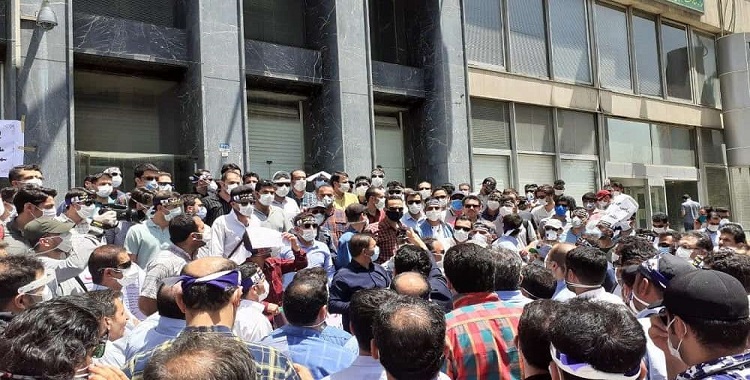The Untold Story of Iran’s Workers

Written by
Sedighe Shahrokhi
iran-oil-workers-protests-min
May first marked International Workers’ Day. Protests were held across the globe, and people yearned for better working conditions. But the Labor Day in Iran was different. Protests in Iran were less covered by the media. This is not because Iranians are enjoying their working condition, which many state-run outlets describe as “modern slavery.”
Low salaries, harsh working conditions, and job insecurity could hardly portray the Iranian workers’ conditions. The country’s economic meltdown, the high rate of unemployment that hovers around 11% according to the state-run media, and the regime’s systematic oppression of the workers’ syndicate leave no room for protests.
In other words, Iranian workers try hard to earn a meager living, and once they demand a decent working environment, they lose their jobs and will be replaced with other workers. Yet, the state-run media frequently report layoffs and strikes by workers who have not received their salaries for months.
Iran sits on the world’s fourth-largest crude oil reserves, but Iranian workers can hardly earn a living. The regime authorities have been shrugging off workers’ demands. As the prices of basic food items grow, the table of workers shrinks.
“Faramarz Towfiqi, head of the wage committee of the Supreme Council of Islamic Labor Councils, conducted a survey based on data from the International Monetary Fund in April 2021, compiling a list of workers’ wages in different countries. This study shows that Iranian workers with a minimum monthly wage of $75 rank 160 and are considered cheap labor force,” the state-run Asr Iran reported on February 21, 2022.
“Interestingly, Burkina Faso holds a higher position than Iran and also Bangladesh. These are impoverished countries. Libya, a country in crisis, is ranked higher than Iran. Even war-torn Iraq is ranked higher than Iran!” Towfiqi added, as quoted by Asr Iran.
Since 2006, the Iranian regime’s supreme leader has called for the “privatization of Iran’s economy.” Fearing their role in terrorism could damage their clandestine financial system, the Revolutionary Guards and Khamenei himself kickstarted the privatization plan in 2006 and gradually handed over the country’s economy to the so-called “private” front companies.
As a result, the so-called “private” companies and contractors enslave Iranian workers, and once they protest the harsh working conditions, they oppress and fire them, and the regime denies its culpability.
“Today, about 99% of workers do not have job security. One of the most important reasons for dismissal in society is the prevalence of temporary employment contracts and the expansion of contractors, which are the cause of labor exploitation in the country. In Iran, privatization has led to poverty, slavery, the dismissal of workers, social anomalies, and the specialization of social justice,” Nasrullah Daryabeigi, Executive Secretary of Mazandaran Workers’ House, told the semi-official ILNA News Agency on May 26, 2021.
Iranian Workers’ Deplorable Conditions
Iranian workers and people from all walks of life face rampant inflation, skyrocketing prices, a plummeting currency, increasing unemployment, systematic clampdown on workers, and banning of independent syndicates.
Workers played a key role in Iran’s 1979 anti-monarchic revolution. The famous oil workers’ strike in 1978 and 1979 brought Shah’s regime to its knees. They had high hopes after the fall of the Shah, but the new ruling theocracy silenced their cries for equality and freedom.
The Iranian workers’ condition has continuously deteriorated over the past four decades, as the regime has been squandering national wealth on terrorism and its secret nuclear weapon program, and what’s left of the country’s resources has been plundered by regime officials.
The new report by Iran’s Ministry of Labor indicates that over one-third of the Iranian population lives in “absolute poverty.”
“According to economists, the absolute poverty line in Iran could increase to 120 million rials. The director-general of the Economic Studies Office of the Parliamentary Research Center stated: The poverty rate in our country has reached about 35%. In other words, 35% of the people are below the poverty line,” the state-run Etemad online reported in January 2022.
After a month of bragging about helping workers, Ebrahim Raisi’s government has only increased workers’ wages by 10%, bringing them to less than 50 million rials. It doesn’t take one to be a mathematician to figure out that all workers live under the poverty line if they receive their wages!
The War in Ukraine and Iranian Workers’ Plight
The world welcomed International Workers’ Day amid the escalating tensions in Ukraine. The war of occupation in Ukraine has sent an economic shockwave through the whole world.
Ukraine is the world’s largest producer of sunflower oil, maintaining more than half of global exports of the product. The country, along with Russia, is also responsible for over a third (36%) of global wheat exports. The war in Ukraine has indeed affected the food supply in the importing countries such as Iran.
Tehran welcomed the war in Ukraine to win the support of Moscow in the ongoing but fruitless nuclear talks with world powers in a bid to be able to sell its oil at a higher price.
In addition to the war’s consequences, since Raisi has eliminated the preferential currency rate, created to allow grains import at a lower price, the prices of bread and pasta are skyrocketing, making these products scarce.
There have been protests in Iran and many warnings by regime officials that since bread has been the workers’ main food item on the table, there would soon be another uprising.
The so-called “preferential rate,” aka the official exchange rate of 42000 rials for a dollar, was initiated in 2016 and allocated to regime insiders, who sold essential consumer goods at higher prices. Yet, the current prices are much higher.

